Thanks to a post from @JesusismyGOD77: An article from Mik Anderson:
Graphene Oxide & Nano-Router Circuitry in Covid Vaccines: Uncovering the True Purpose of These Mandatory Toxic Injections
Pattern Identification in Coronavirus Vaccines: Nanorouters
by Mik Andersen, Corona2Inspect
published in Spanish November 2021
rough translation via translation software
Since graphene oxide was discovered in coronavirus vaccines, all the findings and discoveries made only confirm its presence (Campra, P. 2021). To date, more than reasonable evidence and indications have also been found for the existence of carbon nanotubes and nano-octopuses, mesoporous spheres, colloidal nano-robots; objects that should not be part of any vaccine and that are not declared among the components of the same. Additionally, other types of objects have been identified and evidenced in images of blood samples, of people vaccinated with the coronavirus vaccines, specifically micro-swimmers, nano-antennas of crystallized graphene and graphene quantum dots, as well, known as GQD.
On this occasion, analyzing one of the images obtained by Dr. Campra, corresponding to a sample of the Pfizer vaccine, see figure 1, it has been discovered, which with great probability, is a nanorouter or part of its circuitry. In the original image, a well-defined drop can be seen in which crystalline structures of a quadrangular or cubic format appear. If you look closely, you can see some marks on these crystals, with a regular pattern, well defined in some cases, but limited by the microscope optics.
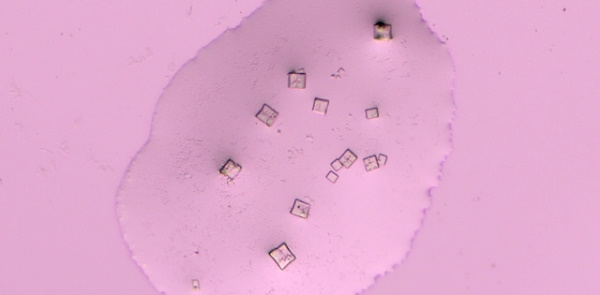
The finding has been possible by isolating each quadrangular crystal, applying a process of rasterizing, focusing and delineating the edges of the image, in order to further pronounce the observed marks. Once this process was completed, a rough draft was drawn with the lines and patterns inscribed on the glass, creating a clean outline of what actually looked like a circuit. The fact of finding parallel and perpendicular lines with a distribution far from the fractal patterns was very striking, which allowed us to automatically infer the possibility that it had been a product of manufacture. For this reason, similar patterns were searched in the scientific literature, which had a similar scheme, similar to the circuit that had just been drawn. The search result was almost immediate, as the pattern of a quantum dot nanorouter was found, as seen in Figure 2.
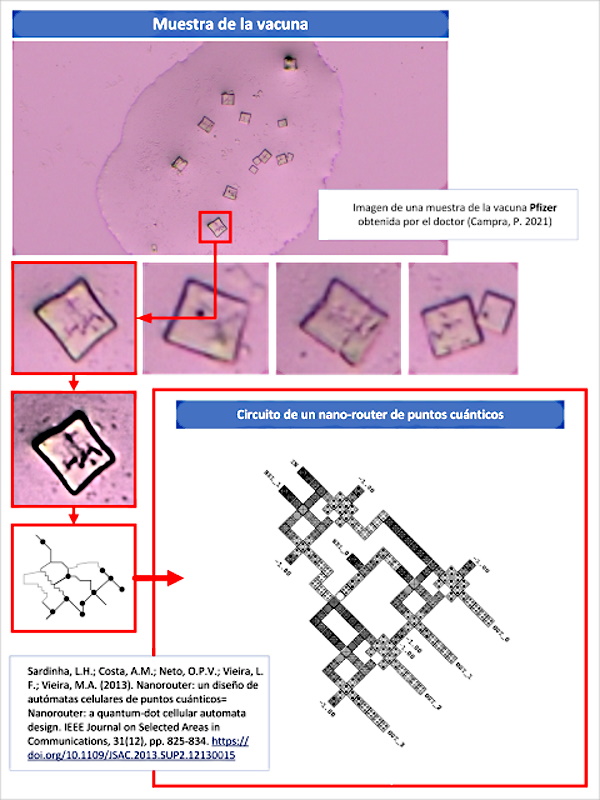
This discovery is of fundamental relevance, not only to understand the true purpose and components of the coronavirus vaccines, but also to explain the existence of the phenomenon of MAC addresses, visible through the bluetooth of many mobile devices.
Discovery context
Before proceeding with the explanation of the finding, it is convenient to remember the context in which it is framed, in order to ensure its understanding and subsequent deepening.
In the first place, it should be borne in mind that graphene and its derivatives, graphene oxide (GO) and carbon nanotubes (CNT), are part of the components of vaccines, according to what has already been stated in this blog. The properties of graphene are exceptional from the physical point of view, but also thermodynamic, electronic, mechanical and magnetic. Its characteristics allow its use as a superconductor, electromagnetic wave absorbing material (microwave EM), emitter, signal receiver, quantum antenna, which makes it possible to create advanced electronics on a nano and micrometric scale. Such is the case, that it is the fundamental nanomaterial for the development of nano-biomedicine (Mitragotri, S .; Anderson, DG; Chen, X .; Chow, EK; Ho, D .; Kabanov, AV; Xu, C. 2015 ), nano-communication networks (Kumar, MR 2019), new drug delivery therapies (Yu, J .; Zhang, Y .; Yan, J .; Kahkoska, AR; Gu, Z. 2018) and treatments against cancer (Huang, G .; Huang, H. 2018) and the neurological treatment of neurodegenerative diseases (John, AA; Subramanian, AP; Vellayappan, MV; Balaji, A .; Mohandas, H .; Jaganathan, SK 2015 ). However, all the benefits aside, the scientific literature is very clear regarding the health implications for the human body. It is well known that graphene (G), graphene oxide (GO) and other derivatives such as carbon nanotubes (CNT) are toxic in almost all their forms, causing mutagenesis, cell death (apoptosis), release of free radicals, lung toxicity , bilateral pneumonia, genotoxicity or DNA damage, inflammation, immunosuppression, damage to the nervous system, the circulatory, endocrine, reproductive, and urinary systems, which can cause anaphylactic death and multi-organ dysfunction, see page “Damages and toxicity of graphene oxide” and from “Damage and toxicity of carbon-graphene nanotubes“.
Second, graphene is a radio-modulable nanomaterial, capable of absorbing electromagnetic waves and multiplying radiation, acting as a nano-antenna, or a signal repeater (Chen, Y .; Fu, X .; Liu, L .; Zhang , Y .; Cao, L .; Yuan, D .; Liu, P. 2019). Exposure to electromagnetic radiation can cause exfoliation of the material in smaller particles (Lu, J .; Yeo, PSE; Gan, CK; Wu, P .; Loh, KP 2011), called graphene quantum dots or GQD (Graphene Quantum Dots), whose physical properties and particularities improve due to their even smaller scale, due to the “Quantum Hall” effect, since they act by amplifying electromagnetic signals (Massicotte, M .; Yu, V .; Whiteway, E .; Vatnik , D .; Hilke, M. 2013 | Zhang, X .; Zhou, Q .; Yuan, M .; Liao, B .; Wu, X .; Ying, M. 2020), and with it the emission distance, especially in environments such as the human body (Chopra, N .; Phipott, M .; Alomainy, A .; Abbasi, QH; Qaraqe, K .; Shubair, RM 2016). GQDs can acquire various morphologies, for example hexagonal, triangular, circular or irregular polygon (Tian, P .; Tang, L .; Teng, K.S .; Lau, S.P. 2018).
The superconducting and transducing capacity make graphene one of the most suitable materials to create wireless nanocommunication networks for the administration of nanotechnology in the human body. This approach has been intensively worked by the scientific community, after having found and analyzed the available protocols and specifications, but also the routing systems for the data packets that nano-devices and nano-nodes would generate within the body, in a system complex called CORONA, whose objective is the effective transmission of signals and data on the network, optimizing energy consumption (to the minimum possible), and also reducing failures in the transmission of data packets (Bouchedjera, IA ; Aliouat, Z .; Louail, L. 2020 | Bouchedjera, IA; Louail, L .; Aliouat, Z .; Harous, S. 2020 | Tsioliaridou, A .; Liaskos, C .; Ioannidis, S .; Pitsillides, A . 2015). In this nanocommunications network, a type of signal TS-OOK (Time-Spread On-Off Keying) is used that allows transmitting binary codes of 0 and 1, through short pulses that involve the activation and deactivation of the signal during time intervals very small of a few femtoseconds (Zhang, R .; Yang, K .; Abbasi, QH; Qaraqe, KA; Alomainy, A. 2017 | Vavouris, AK; Dervisi, FD; Papanikolaou, VK; Karagiannidis, GK 2018). Due to the complexity of nanocommunications in the human body, where the nano-nodes of the network are distributed throughout the body, in many cases in motion, due to blood flow, and in others attached to the endothelium to the arterial walls and capillaries or in the tissues of other organs, researchers have required the development of software for the simulation of such conditions, in order to verify and validate the nanocommunication protocols that were being developed (Dhoutaut, D .; Arrabal, T .; Dedu, E. 2018).
On the other hand, the nanocommunications network oriented to the human body (Balghusoon, A.O .; Mahfoudh, S. 2020), has been carefully designed in its topological aspects, conceiving specialized components in the performance of this task. For example, electromagnetic nanocommunication is made up in its most basic layer by nano-nodes that are devices (presumably made of graphene, carbon nanotubes, GQD, among other objects and materials) that have the ability to interact as nanosensors, piezo-electric actuators , and in any case as nano-antennas that propagate the signals to the rest of the nano-nodes. The nano-nodes, find in the nano-routers (also called nano-controllers) the next step in the topology. Its function is to receive the signals emitted by the nano-nodes, process them and send them to the nano-interfaces, which will emit them to the outside of the body with the necessary frequency and scope, since it must overcome the skin barrier without losing clarity in the signal, so that it can be received by a mobile device at a close enough distance (usually a few meters). That mobile device would actually be a smartphone or any other device with an Internet connection, which allows it to act as a “Gateway”. The topology also defines the possibility that the entire nano-node, nanorouter and nano-interface infrastructure is unified in a single nano-device, called pole or metamaterial defined by SDM software (Lee, SJ; Jung, C. ; Choi, K .; Kim, S. 2015). This model simplifies the topology, but increases the size of the device and the complexity of its construction, conceived in several layers of graphene. In any case, regardless of the topology, nanorouters are necessary to route and decode the signals correctly, for their sending, but also for their reception, since they can be designed for a bidirectional service, which de facto implies the ability to receive signals. of commands, orders, operations that interact with the objects of the network.
To electromagnetic nanocommunication, we must add molecular nanocommunication, addressed in the entry on carbon nanotubes and new evidence in vaccine samples. In both publications, the implications of these objects in the field of neuroscience, neuromodulation and neurostimulation are analyzed, since if they are located in the neuronal tissue (something very likely, given the ability to overcome the blood-brain barrier), they can establish connections that bridge the neuronal synapse. This means that they link neurons with different shortcuts, shorter than natural axons (Fabbro, A .; Cellot, G .; Prato, M .; Ballerini, L. 2011). Although this can be used in experimental treatments to mitigate the effects of neurodegenerative diseases, it can also be used to directly interfere with neurons, the secretion of neurotransmitters such as dopamine, the involuntary activation of certain areas of the brain, their neurostimulation or modulation, through electrical impulses, generated from carbon nanotubes (Suzuki, J .; Budiman, H .; Carr, TA; DeBlois, JH 2013 | Balasubramaniam, S .; Boyle, NT; Della-Chiesa, A .; Walsh, F .; Mardinoglu, A .; Botvich, D .; Prina-Mello, A. 2011), as a result of the reception of electromagnetic signals and pulses from the nanocommunications network (Akyildiz, IF; Jornet, JM 2010). It is not necessary to warn about what it means that an external signal, not controlled by the inoculated person, is the one that governs the segregation of neurotransmitters. Take an example to raise awareness; carbon nanotubes housed in neuronal tissue could interfere with the natural functioning of the secretion of neurotransmitters such as dopamine, which is partly responsible for cognitive processes, socialization, the reward system, desire, pleasure, conditioned learning or inhibition (Beyene, AG; Delevich, K .; Del Bonis-O’Donnell, JT; Piekarski, DJ; Lin, WC; Thomas, AW; Landry, MP 2019 | Sun, F .; Zhou, J .; Dai, B .; Qian, T .; Zeng, J .; Li, X .; Li, Y. 2020 | Sun, F .; Zeng, J .; Jing, M .; Zhou, J .; Feng, J .; Owen, SF; Li, Y. 2018 | Patriarchi, T .; Mohebi, A .; Sun, J .; Marley, A .; Liang, R .; Dong, C .; Tian, L. 2020 | Patriarchi, T .; Cho , JR; Merten, K .; Howe, MW; Marley, A .; Xiong, WH; Tian, L. 2018). This means that it could be inferred in the normal behavior patterns of people, their feelings and thoughts, and even force subliminal conditioned learning, without the individual being aware of what is happening. In addition to the properties already mentioned, carbon nanotubes not only open the doors to the wireless interaction of the human brain, they can also receive electrical signals from neurons and propagate them to nanorouters, since they also have the same properties as GQD graphene nano-antennas and quantum dots, as explained in (Demoustier, S .; Minoux, E .; Le Baillif, M .; Charles, M .; Ziaei, A. 2008 | Wang, Y .; Wu, Q .; Shi, W .; He, X .; Sun, X .; Gui, T. 2008 | Da-Costa, MR; Kibis, OV; Portnoi, ME 2009). This means that they can transmit and monitor the neuronal activity of individuals.
For the data packets emitted and received from the nanocommunications network to reach their destination, it is essential that the communication protocol implements in some way the unique identification of the nanodevices (that is, through MAC) and transmits the information to an IP address. default. In this sense, the human body becomes an IoNT server (from the Internet of NanoThings) in which the communication client / server model can be assimilated. The mechanisms, commands or types of request remain to be determined, as well as the exact frequency and type of signal that operates the wireless nanocommunications network that would be installed with each vaccine, although obviously this information must be very confidential, given the possible consequences of biohacking. (Vassiliou, V. 2011) that could happen. In fact, in the work of (Al-Turjman, F. 2020) the problems and circumstances of the security of nanocommunication networks connected to 5G (confidentiality, authentication, privacy, trust, intrusions, repudiation) are linked and additionally, it presents a summary of the operation of electromagnetic communication between nano-nodes, nano-sensors and nano-routers, using graphene antennas and transceivers for their link with data servers, in order to develop Big-data projects. It should be noted that the risks of network hacking are very similar to those that can be perpetrated in any network connected to the Internet (masquerade attack, location tracking, information traps, denial of service, nano-device hijacking, wormhole, MITM broker attack, malware, spam, sybil, spoofing, neurostimulation illusion attack), which means a potential and additional, very serious risk for people inoculated with the hardware of a nanocommunication network.
In this context, it is in which the discovery of the circuits of a nanorouter in the samples of the Pfizer vaccine is found, which is a key piece in all the research that has been carried out and that would confirm the installation of a hardware in the body of inoculated people, without their informed consent, which executes collection and interaction processes that are completely beyond its control.
Nanorouters QCA
The discovered circuit, see figure 3, corresponds to the field of quantum dot cellular automata, also known as QCA (Quantum Cellular Automata), characterized by its nanometric scale and a very low energy consumption, as an alternative for the replacement of technology based on transistors. This is how it is defined by the work of (Sardinha, L.H .; Costa, A.M .; Neto, O.P.V .; Vieira, L.F .; Vieira, M.A. 2013) from which the scheme of said circuit was obtained. The nanorouter referred to by the researchers is characterized by an ultra-low consumption factor, high processing speed (its frequency clock operates in a range of 1-2 THz), which is consistent with the power conditions and data transfer requirements. , in the context of nanocommunication networks for the human body described by (Pierobon, M .; Jornet, JM; Akkari, N .; Almasri, S .; Akyildiz, IF 2014).
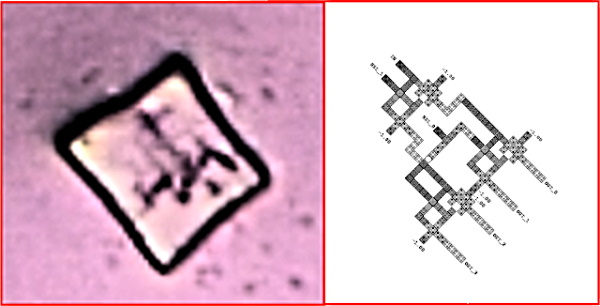
According to the explanations of the work of (Sardinha, LH; Costa, AM; Neto, OPV; Vieira, LF; Vieira, MA 2013), the concept of quantum dot and quantum dot cell is distinguished, see figure 4. The QCA cell It is made up of four quantum dots whose polarization is variable. This makes it possible to distinguish the binary code of 0 and 1 based on the positive or negative charge of the quantum dots. In the words of the authors it is explained as follows “The basic units of QCA circuits are cells made of quantum dots. A point, in this context, is just a region where an electrical charge can be located or not. A cell QCA has four quantum dots located in the corners. Each cell has two free and moving electrons that can tunnel between the quantum dots. It is assumed that tunneling to the outside of the cell is not allowed due to a high barrier potential”. Extrapolated to graphene quantum dots, known as GQDs, which were identified in blood samples (due to emitted fluorescence), a QCA cell would require four GQDs to compose, which is perfectly consistent with the description given by the researchers. This is also corroborated by (Wang, Z.F .; Liu, F. 2011) in his work entitled “Graphene quantum dots as building blocks for quantum cellular automata”, where the use of graphene to create this type of circuit is confirmed.
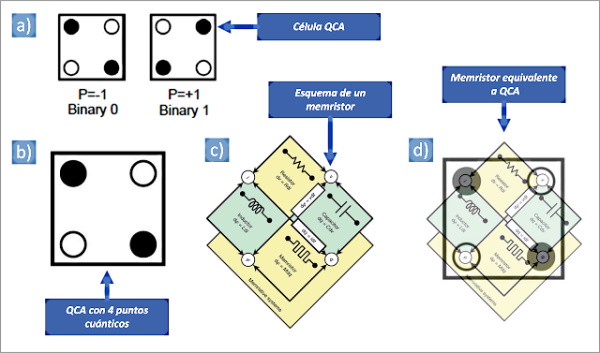
When the QCA cells are combined, cables and circuits are created, with a wide variety of shapes, schemes and applications, as can be seen in figure 5, where inverters, crossovers and logic gates are observed, also addressed by other authors such as ( Xia, Y .; Qiu, K. 2008). This gives rise to more complex structures, which allow to reproduce the electronic diagrams of the transistors, processors, transceivers, multiplexers, demultiplexers and consequently of any router.
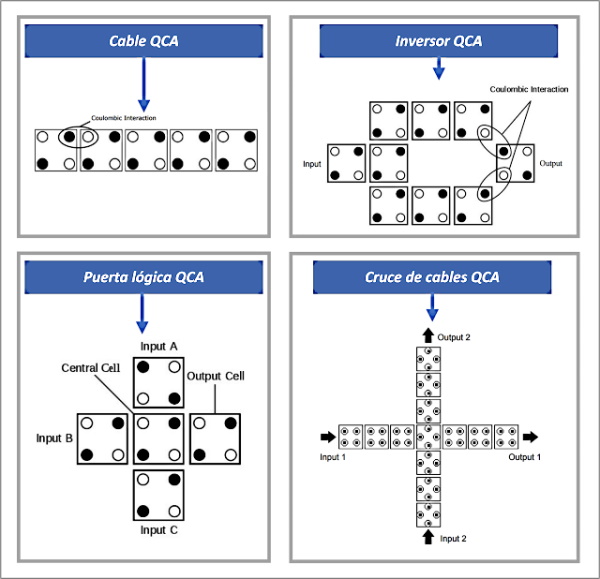
It is important to explain that QCA cell-based circuits can operate in several superimposed layers, which allows a 3D (three-dimensional) structure to create much more complex and compressed electronics, see figure 6.
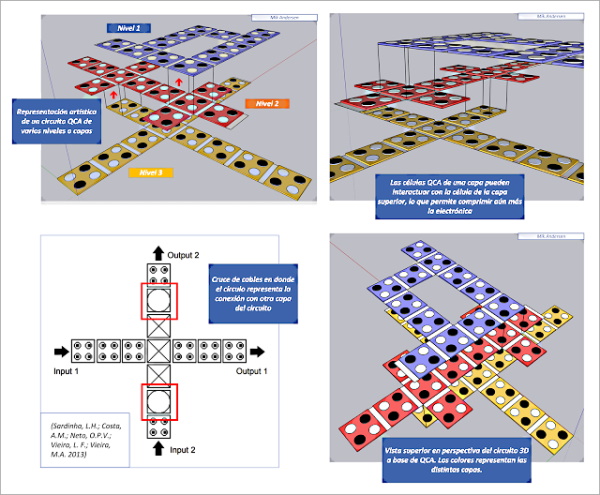
To develop a nanorouter, according to the researchers (Sardinha, LH; Costa, AM; Neto, OPV; Vieira, LF; Vieira, MA 2013), several circuit structures are needed, specifically, cable crossings (which form logic gates ), demultiplexers (demux) and parallel to serial converters, see figure X. “Demux” are electronic devices capable of receiving a signal at the input QCA (input) and sending it to one of several available output lines. (output), which allows the signal to be routed for further processing. The parallel-to-series converter is a circuit capable of taking several sets of data in an input (input), transporting them through different QCA cables and transmitting them at different instants of time through the output cables (output). This would be very, the component noticed in the vaccine samples, see figure 7.
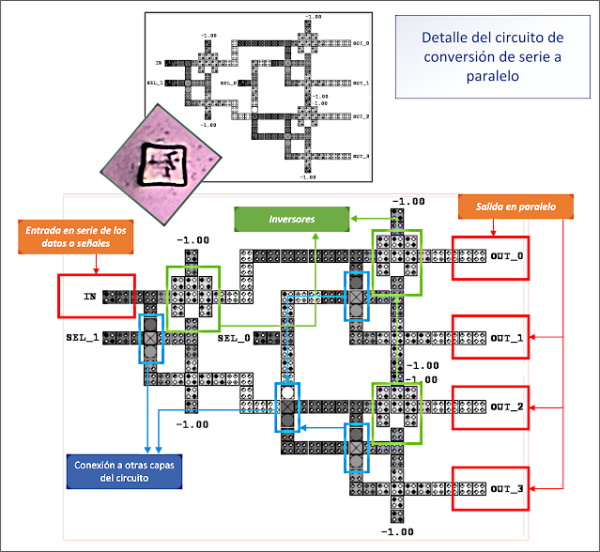
Another relevant aspect of the work of (Sardinha, LH; Costa, AM; Neto, OPV; Vieira, LF; Vieira, MA 2013) is the demonstration of the operation of the circuit, where the reception of a TS-OOK signal and its conversion to binary code, see figure 8. Once the binary code is obtained, the “demux” circuit is responsible for generating the data packets, according to the structure of the corresponding communications protocol.
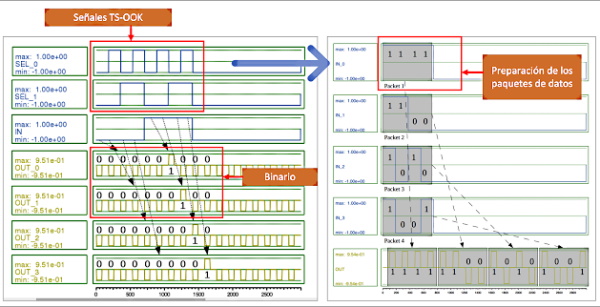
Everything explained by (Sardinha, LH; Costa, AM; Neto, OPV; Vieira, LF; Vieira, MA 2013) is also corroborated by (Das, B .; Das, JC; De, D .; Paul, AK 2017) In whose research, QCA circuit designs for demux and nanorouters are observed, with very similar schemes, to those already presented, which confirms the search for solutions for the problem of the transmission and simple processing of signals and data at the nanometric scale, at in order to make nanocommunication networks effective.
Finally, although it can already be deduced from the nature, characteristics and properties of QCA cell circuits, the concept of clock speed must be highlighted. In fact, interesting is the ability of these electronic components to operate almost autonomously, without the need for a dedicated processor. This is because the QCA cell cables can measure the transfer time of the signals between the different cells, in what is called “clock zones”, see figure 9 and the following investigations (Sadeghi, M .; Navi, K .; Dolatshahi, M. 2020 | Laajimi, R .; Niu, M. 2018 | Reis, DA; Torres, FS 2016 | Mohammadyan, S .; Angizi, S .; Navi, K. (2015). This effect allows the transmission of signals through the circuit, but it also allows creating a clock frequency, which is its own process speed. If this concept is joined, the use of superconducting materials such as graphene and more specifically graphene quantum dots Then very high processing speeds can be achieved.
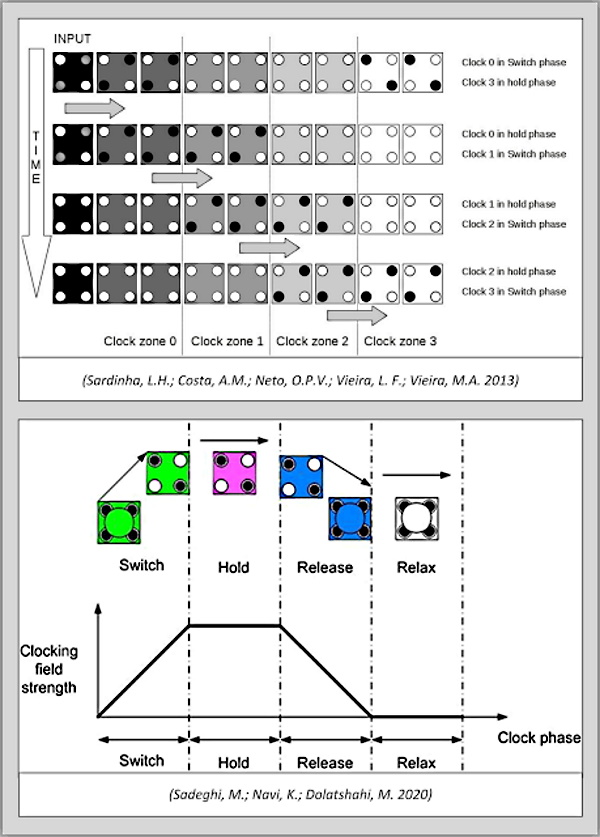
Circuit self-assembly
Although it seems impossible, the self-assembly of circuits is a possibility to consider in the hypothesis that has been explained. According to (Huang, J .; Momenzadeh, M .; Lombardi, F. 2007) “Recent developments in QCA manufacturing (involving molecular implementations) have substantially changed the nature of processing. At very small feature sizes, it is anticipated self-assembly or large-scale cell deposition on isolated substrates will be used. In these implementations, QCA cells (each composed of two dipoles) are deposited in parallel V-shaped tracks. QCA cells are arranged in a dense pattern and the computation occurs between adjacent cells. These fabrication techniques are well suited for molecular implementation. ” However, there are also other methods, such as DNA nanopatterns (Hu, W .; Sarveswaran, K .; Lieberman, M .; Bernstein, GH 2005), with which a template is created for the alignment of the quantum dots of graphene, forming the QCA cells, thereby generating the aforementioned circuitry, see figure 10.
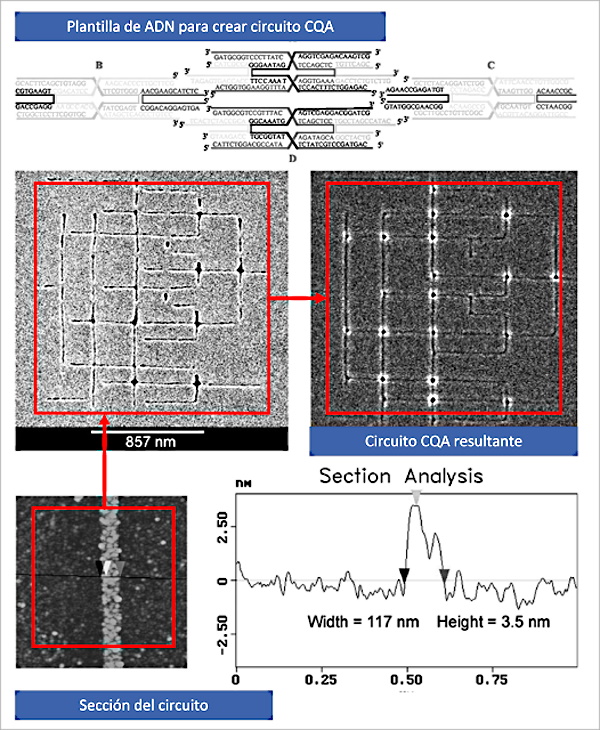
According to (Hu, W .; Sarveswaran, K .; Lieberman, M .; Bernstein, GH 2005) “Four-tile DNA rafts have been successfully synthesized and characterized by the gel electrophoresis method in our previous work” according to the work of (Sarveswaran, K. 2004). This fits with the very possible existence of a gel / hydrogel in the vaccine composition, after the doctor’s micro-Raman analysis (Campra, P. 2021) in which peaks with values close to 1450 were obtained, which could correspond to PVA, PQT-12, polyolefin, polyacrylamide or polypyrrole, all of them components recognized in the scientific literature as gels and derivatives. On the other hand, it explicitly alludes to the electrophoresis method, or what is the same, the electrical polarization process that causes teslaphoresis, on carbon nanotubes, graphene, quantum dots and other semiconductors, as described (Bornhoeft, LR; Castillo, AC; Smalley, PR; Kittrell, C .; James, DK; Brinson, BE; Cherukuri, P. 2016) in his research. This would confirm that teslaphoresis plays a fundamental role in the composition of circuits, along with DNA patterns. If this is confirmed, it would mean that the circuits could self-assemble in the presence of electric fields or even the reception of electromagnetic waves (microwave EM). The study by (Pillers, M .; Goss, V .; Lieberman, M. 2014) also confirms the construction of nanostructures and CQA using in this case graphene, graphene oxide (GO), electrophoresis and gel, causing controlled deposition in the areas indicated by the DNA pattern, reproducing results similar to those presented in the study by Hu and Sarveswaran, thus making it possible to create the electronic circuits already mentioned, see figure 11.
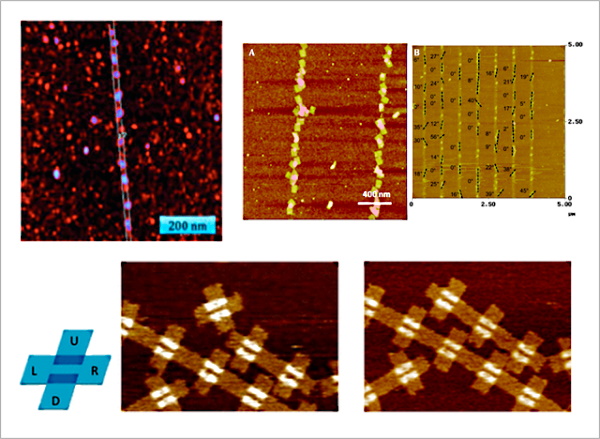
Plasmonic nano-emitters
Another issue that requires an explanation in the discovery of the circuit of a nanorouter, in the vaccine sample, is its location in what appears to be a quadrangular crystal. Although it could be thought that it is a randomly generated form, the bibliographic review reveals and justifies this type of form that serves as a framework for this type of circuit. In reality it is a “plasmonic nano-emitter”, in other words, it would correspond to a cubic-shaped nano-antenna (single crystal) of variable size on the nano-micrometric scale, which can emit, receive or repeat signals. This is possible through the plasmon activation property of its surface (that of the nanoemitter cube) that is locally excited to generate an oscillatory signal, as explained (Ge, D .; Marguet, S .; Issa, A .; Jradi, S .; Nguyen, TH; Nahra, M .; Bachelot, R. 2020), see figure 12. This agrees with the type of TS-OOK signals, which are transmitted through the intra-body nanocommunication network, being a requirement indispensable for a nano-router, to have a method to capture them. In other words, the crystalline cube acts as a transceiver for the nanorouter, due to its special properties, derived from the physics of the plasmon. This is corroborated when the scientific literature on electromagnetic nano-networks for the human body is consulted (Balghusoon, AO; Mahfoudh, S. 2020), the MAC protocols applied to the case (Jornet, JM; Pujol, JC; Pareta, JS 2012 ), the methods for the debugging of errors in the signals (Jornet, JM; Pierobon, M .; Akyildiz, IF 2008), or the modulation of pulses in femtoseconds in the terahertz band for nano-communication networks (Jornet, JM; Akyildiz, IF 2014), the parameterization of nano-networks for their perpetual operation (Yao, XW; Wang, WL; Yang, SH 2015), the performance in the modulation of wireless signals for nano-networks (Zarepour, E .; Hassan, M .; Chou, CT; Bayat, S. 2015). In all cases, nano-transceivers are essential to be able to receive or emit a TS-OOK signal.
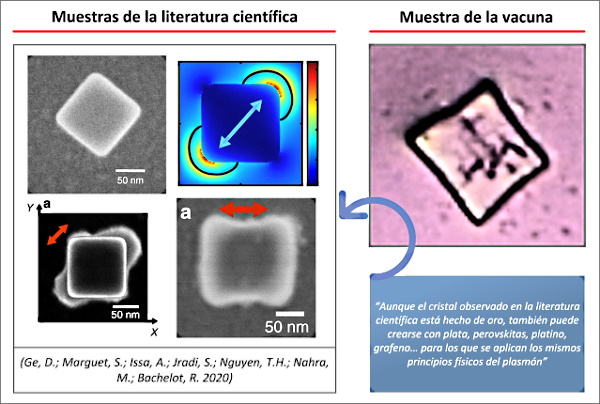
Plasmonic nanoemitters can acquire a cube shape, which would be the case observed in the vaccine sample, but also spherical and discoidal shape, being able to be self-assembled, to form larger nano-microstructures (Devaraj, V .; Lee, JM; Kim , YJ; Jeong, H .; Oh, JW 2021). Among the materials with which this plasmonic nano-emitter could be produced are gold, silver, perovskites and graphene, see (Oh, DK; Jeong, H .; Kim, J .; Kim, Y .; Kim, I .; Ok, JG; Rho, J. 2021 | Hamedi, HR; Paspalakis, E .; Yannopapas, V. 2021 | Gritsienko, AV; Kurochkin, NS; Lega, PV; Orlov, AP; Ilin, AS; Eliseev, SP; Vitukhnovsky , AG 2021 | Pierini, S. 2021), although it is likely that many others can be used.
CAM and TCAM memory for MAC and IP
If the presence of nanorouters in vaccines is considered, the hypothesis of the existence of one or more MAC addresses (fixed or dynamic) could be confirmed, which could be emitted from vaccinated people or through some other intermediary device (for example a mobile phone ). This approach is in line with what has already been explained and evidenced in this publication, but also according to scientific publications on nano-communication networks for the human body. According to (Abadal, S .; Liaskos, C .; Tsioliaridou, A .; Ioannidis, S .; Pitsillides, A .; Solé-Pareta, J .; Cabellos-Aparicio, A. 2017) these MAC addresses allow the nano- network can transmit and receive data, because the individual has a unique identifier that allows him to access the medium, this is the Internet. In this way, the nano-router can receive the signals corresponding to the data from the nano-sensors and nano-nodes of the nano-network to transmit them to the outside of the body, as long as there is a mobile device in the vicinity, which serves gateway to the Internet. Therefore, the hypothesis that MAC addresses of vaccinated people can be observed (through bluetooth signal tracking applications), when there is some type of interaction with the mobile media that act as a link. This does not mean that there is permanent communication, due to the need to save and optimize energy consumption (Mohrehkesh, S .; Weigle, MC 2014 | Mohrehkesh, S .; Weigle, MC; Das, SK 2015), which could explain intermittence in communications, periods of connection and inactivity.
The novelty in the field of MAC addresses, which comes together with the QCA circuits, with which nanorouters can be developed, is that memory circuits can also be created. The same researchers (Sardinha, LH; Silva, DS; Vieira, MA; Vieira, LF; Neto, OPV 2015) developed a new type of CAM memory that “unlike random access memory (RAM), which returns data which are stored at the given address. CAM, however, receives the data as input and returns where the data can be found. CAM is useful for many applications that need fast searches, such as Hought transforms, Huffman encoding, Lempel-compression. Ziv and network switches to map MAC addresses to IP addresses and vice versa. CAM is most useful for creating tables that look for exact matches, such as MAC address tables. ” This statement was extracted and copied verbatim to highlight that QCA circuits are the answer to the storage and management of MAC addresses for data transmission in nano-networks, which would confirm that vaccines are, among other things, a means of installing hardware for the control, modulation and monitoring of people.
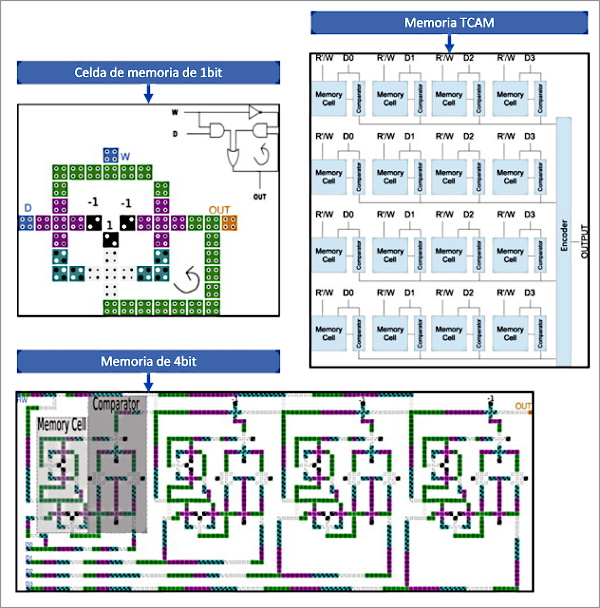
Additionally, (Sardinha, LH; Silva, DS; Vieira, MA; Vieira, LF; Neto, OPV 2015) also developed the TCAM memory, which is a special type of CAM memory that would be useful to “create tables to search for longer matches such as IP routing tables organized by IP prefixes. To reduce latency and make communication faster, routers use TCAM. ” This statement clearly affects its use in nano-routers in order to be able to transmit the data obtained in the nano-network to a specific recipient server accessible on the Internet. In other words, the data collected by the nano-network should be stored / registered in a database, of which the recipient of the vaccine would not have knowledge of its existence, of which it was not informed, and in the It is unknown what information is used.
Bibliography
- Akyildiz, I.F.; Jornet, J.M. (2010). Redes de nanosensores inalámbricos electromagnéticos = Electromagnetic wireless nanosensor networks. Nano Communication Networks, 1(1), pp. 3-19. https://doi.org/10.1016/j.nancom.2010.04.001
- Al-Turjman, F. (2020). Inteligencia y seguridad en un gran IoNT orientado a 5G: descripción general = Intelligence and security in big 5G-oriented IoNT: An overview. Future Generation Computer Systems, 102, pp. 357-368. https://doi.org/10.1016/j.future.2019.08.009
- Balasubramaniam, S.; Boyle, N.T.; Della-Chiesa, A.; Walsh, F.; Mardinoglu, A.; Botvich, D.; Prina-Mello, A. (2011). Desarrollo de redes neuronales artificiales para la comunicación molecular = Development of artificial neuronal networks for molecular communication. Nano Communication Networks, 2(2-3), pp. 150-160. https://doi.org/10.1016/j.nancom.2011.05.004
- Balghusoon, A.O.; Mahfoudh, S. (2020). Protocolos de enrutamiento para redes inalámbricas de nanosensores e Internet de las nano cosas: una revisión completa = Routing Protocols for Wireless Nanosensor Networks and Internet of Nano Things: A Comprehensive Survey. IEEE Access, 8, pp. 200724-200748. https://doi.org/10.1109/ACCESS.2020.3035646
- Beyene, A.G.; Delevich, K.; Del Bonis-O’Donnell, J.T.; Piekarski, D.J.; Lin, W.C.; Thomas, A.W.; Landry, M.P. (2019). Obtención de imágenes de la liberación de dopamina estriatal utilizando un nanosensor de catecolamina fluorescente de infrarrojo cercano no codificado genéticamente = Imaging striatal dopamine release using a nongenetically encoded near infrared fluorescent catecholamine nanosensor. Science advances, 5(7), eaaw3108. https://doi.org/10.1126/sciadv.aaw3108
- Bornhoeft, L.R.; Castillo, A.C.; Smalley, P.R.; Kittrell, C.; James, D.K.; Brinson, B.E.; Cherukuri, P. (2016). Teslaforesis de nanotubos de carbono = Teslaphoresis of carbon nanotubes. ACS nano, 10(4), pp. 4873-4881. https://doi.org/10.1021/acsnano.6b02313
- Bouchedjera, I.A.; Aliouat, Z.; Louail, L. (2020). EECORONA: Sistema de Coordinación y Enrutamiento de Eficiencia Energética para Nanoredes = EECORONA: Energy Efficiency Coordinate and Routing System for Nanonetworks. En: International Symposium on Modelling and Implementation of Complex Systems. Cham. pp. 18-32. https://doi.org/10.1007/978-3-030-58861-8_2
- Bouchedjera, I.A.; Louail, L.; Aliouat, Z.; Harous, S. (2020). DCCORONA: Sistema distribuido de enrutamiento y coordenadas basado en clústeres para nanorredes = DCCORONA: Distributed Cluster-based Coordinate and Routing System for Nanonetworks. En: 2020 11th IEEE Annual Ubiquitous Computing, Electronics & Mobile Communication Conference (UEMCON). IEEE. pp. 0939-0945. https://doi.org/10.1109/UEMCON51285.2020.9298084
- Campra, P. (2021a). Observaciones de posible microbiótica en vacunas COVID RNAm Version 1. [Observations of possible microbiotics in COVID mRNA vaccines] http://dx.doi.org/10.13140/RG.2.2.13875.55840
- Campra, P. (2021b). Detección de grafeno en vacunas COVID19 por espectroscopía Micro-RAMAN. https://www.researchgate.net/publication/355684360_Deteccion_de_grafeno_en_vacunas_COVID19_por_espectroscopia_Micro-RAMAN
- Campra, P. (2021c). MICROSTRUCTURES IN COVID VACCINES: ¿inorganic crystals or Wireless Nanosensors Network?https://www.researchgate.net/publication/356507702_MICROSTRUCTURES_IN_COVID_VACCINES_inorganic_crystals_or_Wireless_Nanosensors_Network
- Chopra, N.; Phipott, M.; Alomainy, A.; Abbasi, Q.H.; Qaraqe, K.; Shubair, R.M. (2016). THz time domain characterization of human skin tissue for nano-electromagnetic communication. En: 2016 16th Mediterranean Microwave Symposium (MMS) (pp. 1-3). IEEE. https://doi.org/10.1109/MMS.2016.7803787
- Da-Costa, M.R.; Kibis, O.V.; Portnoi, M.E. (2009). Nanotubos de carbono como base para emisores y detectores de terahercios = Carbon nanotubes as a basis for terahertz emitters and detectors. Microelectronics Journal, 40(4-5), pp. 776-778. https://doi.org/10.1016/j.mejo.2008.11.016
- Das, B.; Das, J.C.; De, D.; Paul, A.K. (2017). Diseño de nanoenrutador para nanocomunicación en autómatas celulares cuánticos de una sola capa =Nano-Router Design for Nano-Communication in Single Layer Quantum Cellular Automata. En: International Conference on Computational Intelligence, Communications, and Business Analytics (pp. 121-133). Springer, Singapore. https://doi.org/10.1007/978-981-10-6430-2_11
- Demoustier, S.; Minoux, E.; Le Baillif, M.; Charles, M.; Ziaei, A. (2008). Revisión de dos aplicaciones de microondas de nanotubos de carbono: nano antenas y nanointerruptores = Revue d’applications des nanotubes de carbone aux micro-ondes: nano-antennes et nano-commutateurs = Review of two microwave applications of carbon nanotubes: nano-antennas and nano-switches. Comptes Rendus Physique, 9(1), pp. 53-66. https://doi.org/10.1016/j.crhy.2008.01.001
- Devaraj, V.; Lee, J.M.; Kim, Y.J.; Jeong, H.; Oh, J.W. (2021). [Pre-print]. Diseño de nanoestructuras plasmónicas autoensambladas eficientes a partir de nanopartículas de forma esférica = Designing an Efficient Self-Assembled Plasmonic Nanostructures from Spherical Shaped Nanoparticles. International Journal of Molecular Science. https://www.preprints.org/manuscript/202109.0225/v1
- Dhoutaut, D.; Arrabal, T.; Dedu, E. (2018). Bit Simulator, un simulador de nanorredes electromagnéticas = Bit simulator, an electromagnetic nanonetworks simulator. En: Proceedings of the 5th ACM International Conference on Nanoscale Computing and Communication (pp. 1-6). https://doi.org/10.1145/3233188.3233205
- Fabbro, A.; Cellot, G.; Prato, M.; Ballerini, L. (2011). Interconexión de neuronas con nanotubos de carbono: (re) ingeniería de la señalización neuronal = Interfacing neurons with carbon nanotubes: (re) engineering neuronal signaling. Progress in brain research, 194, pp. 241-252. https://doi.org/10.1016/B978-0-444-53815-4.00003-0
- Ferjani, H.; Touati, H. (2019). Comunicación de datos en nano-redes electromagnéticas para aplicaciones sanitarias = Data communication in electromagnetic nano-networks for healthcare applications. En: International Conference on Mobile, Secure, and Programmable Networking (pp. 140-152). Springer, Cham. https://doi.org/10.1007/978-3-030-22885-9_13
- Ge, D.; Marguet, S.; Issa, A.; Jradi, S.; Nguyen, T.H.; Nahra, M.; Bachelot, R. (2020). Nanoemisores plasmónicos híbridos con posicionamiento controlado de un único emisor cuántico en el campo de excitación local = Hybrid plasmonic nano-emitters with controlled single quantum emitter positioning on the local excitation field. Nature communications, 11(1), pp1-11. https://doi.org/10.1038/s41467-020-17248-8
- Gritsienko, A.V.; Kurochkin, N.S.; Lega, P.V.; Orlov, A.P.; Ilin, A.S.; Eliseev, S.P.; Vitukhnovsky, A.G. (2021). Propiedades ópticas de la nueva nanoantena híbrida en cavidad submicrónica = Optical properties of new hybrid nanoantenna in submicron cavity. En: Journal of Physics: Conference Series (Vol. 2015, No. 1, p. 012052). IOP Publishing. https://doi.org/10.1088/1742-6596/2015/1/012052
- Hamedi, H.R.; Paspalakis, E.; Yannopapas, V. (2021). Control efectivo de la biestabilidad óptica de un emisor cuántico de tres niveles cerca de una metauperficie plasmónica nanoestructurada = Effective Control of the Optical Bistability of a Three-Level Quantum Emitter near a Nanostructured Plasmonic Metasurface. En: Photonics (Vol. 8, No. 7, p. 285). Multidisciplinary Digital Publishing Institute. https://doi.org/10.3390/photonics8070285
- Hu, W.; Sarveswaran, K.; Lieberman, M.; Bernstein, G.H. (2005). Litografía por haz de electrones de alta resolución y nanopatrones de ADN para QCA molecular. IEEE Transactions on Nanotechnology, 4(3), pp. 312-316. https://doi.org/10.1109/TNANO.2005.847034
- Huang, G.; Huang, H. (2018). Aplicación de dextrano como portadores de fármacos a nanoescala = Application of dextran as nanoscale drug carriers. Nanomedicine, 13(24), pp. 3149-3158. https://doi.org/10.2217/nnm-2018-0331
- Huang, J.; Momenzadeh, M.; Lombardi, F. (2007). Diseño de circuitos secuenciales por autómatas celulares de puntos cuánticos = Design of sequential circuits by quantum-dot cellular automata. Microelectronics Journal, 38(4-5), pp. 525-537. https://doi.org/10.1016/j.mejo.2007.03.013
- Huang, J.; Xie, G.; Kuang, R.; Deng, F.; Zhang, Y. (2021). Circuito de código Hamming basado en QCA para redes de nanocomunicación = QCA-based Hamming code circuit for nano communication network. Microprocessors and Microsystems, 84, 104237. https://doi.org/10.1016/j.micpro.2021.104237
- John, A.A.; Subramanian, A.P.; Vellayappan, M.V.; Balaji, A.; Mohandas, H.; Jaganathan, S.K. (2015). Los nanotubos de carbono y el grafeno como candidatos emergentes en la neurorregeneración y la administración de neurofármacos = Carbon nanotubes and graphene as emerging candidates in neuroregeneration and neurodrug delivery. International journal of nanomedicine, 10, 4267. https://dx.doi.org/10.2147%2FIJN.S83777
- Jornet, J.M.; Akyildiz, I.F. (2014). Modulación basada en pulsos de femtosegundo largo para comunicación en banda de terahercios en nanorredes = Femtosecond-long pulse-based modulation for terahertz band communication in nanonetworks. IEEE Transactions on Communications, 62(5), pp. 1742-1754. https://doi.org/10.1109/TCOMM.2014.033014.130403
- Jornet, J.M.; Pierobon, M.; Akyildiz, I.F. (2008). Redes de nanocomunicación = Nano Communication Networks. Networks (Elsevier), 52, pp. 2260-2279. http://dx.doi.org/10.1016/j.nancom.2014.04.001
- Jornet, J.M.; Pujol, J.C.; Pareta, J.S. (2012). PHLAME: un protocolo MAC consciente de la capa física para nanorredes electromagnéticas en la banda de terahercios = Phlame: A physical layer aware mac protocol for electromagnetic nanonetworks in the terahertz band. Nano Communication Networks, 3(1), pp. 74-81. https://doi.org/10.1016/j.nancom.2012.01.006
- Kumar, M.R. (2019). Una nano-antena compacta basada en grafeno para la comunicación en nano-redes = A Compact Graphene Based Nano-Antenna for Communication in Nano-Network. Journal of the Institute of Electronics and Computer, 1(1), pp. 17-27. https://doi.org/10.33969/JIEC.2019.11003
- Laajimi, R.; Niu, M. (2018). Nanoarquitectura de autómatas celulares de puntos cuánticos (QCA) que utilizan áreas pequeñas para circuitos digitales = Nanoarchitecture of Quantum-Dot Cellular Automata (QCA) Using Small Area for Digital Circuits. Advanced Electronics Circuits–Principles, Architectures and Applications on Emerging Technologies, pp. 67-84. https://www.intechopen.com/chapters/58619
- Lee, S.J.; Jung, C.; Choi, K.; Kim, S. (2015). Diseño de redes inalámbricas de nanosensores para aplicaciones intracuerpo = Design of wireless nanosensor networks for intrabody application. International Journal of Distributed Sensor Networks, 11(7), 176761. https://doi.org/10.1155/2015/176761
- Lu, J.; Yeo, P.S.E.; Gan, C.K.; Wu, P.; Loh, K.P. (2011). Transformando moléculas C60 en puntos cuánticos de grafeno = Transforming C60 molecules into graphene quantum dots. Nature nanotechnology, 6(4), pp. 247-252. https://doi.org/10.1038/nnano.2011.30
- Massicotte, M.; Yu, V.; Whiteway, E.; Vatnik, D.; Hilke, M. (2013). Efecto Hall cuántico en el grafeno fractal: crecimiento y propiedades de los grafloconos = Quantum Hall effect in fractal graphene: growth and properties of graphlocons. Nanotechnology, 24(32), 325601. https://doi.org/10.1088/0957-4484/24/32/325601
- Mitragotri, S.; Anderson, D.G.; Chen, X.; Chow, E.K.; Ho, D.; Kabanov, A.V.; Xu, C. (2015). Acelerando la traducción de nanomateriales en biomedicina = Accelerating the translation of nanomaterials in biomedicine. ACS nano, 9(7), pp. 6644-6654. https://doi.org/10.1021/acsnano.5b03569
- Mohammadyan, S.; Angizi, S.; Navi, K. (2015). Nueva celda sumadora completa QCA de una sola capa basada en el modelo de retroalimentación = New fully single layer QCA full-adder cell based on feedback model. International Journal of High Performance Systems Architecture, 5(4), pp. 202-208. https://doi.org/10.1504/IJHPSA.2015.072847
- Mohrehkesh, S.; Weigle, M.C. (2014). Optimización del consumo de energía en nanorredes de banda de terahercios = Optimizing energy consumption in terahertz band nanonetworks. IEEE Journal on Selected Areas in Communications, 32(12), pp. 2432-2441. https://doi.org/10.1109/JSAC.2014.2367668
- Mohrehkesh, S.; Weigle, M.C.; Das, S.K. (2015). DRIH-MAC: una MAC de recolección iniciada por un receptor distribuido para nanorredes = DRIH-MAC: A distributed receiver-initiated harvesting-aware MAC for nanonetworks. IEEE Transactions on Molecular, Biological and Multi-Scale Communications, 1(1), pp. 97-110. https://doi.org/10.1109/TMBMC.2015.2465519
- Oh, D.K.; Jeong, H.; Kim, J.; Kim, Y.; Kim, I.; Ok, J.G.; Rho, J. (2021). Enfoques de nanofabricación de arriba hacia abajo hacia estructuras de escala nanométrica de un solo dígito = Top-down nanofabrication approaches toward single-digit-nanometer scale structures. Journal of Mechanical Science and Technology, pp. 1-23. https://doi.org/10.1007/s12206-021-0243-7
- Patriarchi, T.; Cho, J.R.; Merten, K.; Howe, M.W.; Marley, A.; Xiong, W.H.; Tian, L. (2018). Imágenes neuronales ultrarrápidas de la dinámica de la dopamina con sensores codificados genéticamente diseñados = Ultrafast neuronal imaging of dopamine dynamics with designed genetically encoded sensors. Science, 360(6396). https://doi.org/10.1126/science.aat4422
- Patriarchi, T.; Mohebi, A.; Sun, J.; Marley, A.; Liang, R.; Dong, C.; Tian, L. (2020). Una paleta ampliada de sensores de dopamina para imágenes multiplex in vivo = An expanded palette of dopamine sensors for multiplex imaging in vivo. Nature methods, 17(11), pp. 1147-1155. https://doi.org/10.1038/s41592-020-0936-3
- Pierini, S. (2021). [Preprint]. Estudio experimental de nanocristales de perovskita como fuentes de fotón único para fotónica cuántica integrada = Experimental study of perovskite nanocrystals as single photon sources for integrated quantum photonics. Arxiv. https://arxiv.org/pdf/2105.14245.pdf
- Pierobon, M.; Jornet, J.M.; Akkari, N.; Almasri, S.; Akyildiz, I.F. (2014). Un marco de enrutamiento para redes de nanosensores inalámbricos de recolección de energía en la banda de terahercios = A routing framework for energy harvesting wireless nanosensor networks in the Terahertz Band. Wireless networks, 20(5), pp. 1169-1183. https://doi.org/10.1007/s11276-013-0665-y
- Pillers, M.; Goss, V.; Lieberman, M. (2014). Litografía por haz de electrones y despegue molecular para la fijación dirigida de nanoestructuras de ADN sobre silicio: de arriba hacia abajo se encuentra con de abajo hacia arriba = Electron-beam lithography and molecular liftoff for directed attachment of DNA nanostructures on silicon: Top-down meets bottom-up. Accounts of chemical research, 47(6), pp. 1759-1767. https://doi.org/10.1021/ar500001e
- Reis, D.A.; Torres, F.S. (2016). Un simulador de defectos para el análisis de robustez de circuitos QCA = A Defects Simulator for Robustness Analysis of QCA Circuits. Journal of Integrated Circuits and Systems, 11(2), pp. 86-96. https://doi.org/10.29292/jics.v11i2.433
- Sadeghi, M.; Navi, K.; Dolatshahi, M. (2020). Nuevos diseños eficientes de sumador completo y restador completo en autómatas celulares cuánticos = Novel efficient full adder and full subtractor designs in quantum cellular automata. The Journal of Supercomputing, 76(3), pp. 2191-2205. https://doi.org/10.1007/s11227-019-03073-4
- Sardinha, L.H.; Costa, A.M.; Neto, O.P.V.; Vieira, L.F.; Vieira, M.A. (2013). NanoRouter: un diseño de autómatas celulares de puntos cuánticos = Nanorouter: a quantum-dot cellular automata design. IEEE Journal on Selected Areas in Communications, 31(12), pp. 825-834. https://doi.org/10.1109/JSAC.2013.SUP2.12130015
- Sardinha, L.H.; Silva, D.S.; Vieira, M.A.; Vieira, L.F.; Neto, O.P.V. (2015). TCAM / CAM-QCA: Memoria direccionable de contenido (ternario) utilizando autómatas celulares de punto cuántico = Tcam/cam-qca:(ternary) content addressable memory using quantum-dot cellular automata. Microelectronics Journal, 46(7), pp. 563-571. https://doi.org/10.1016/j.mejo.2015.03.020
- Sarveswaran, K. (2004). [Documento reservado]. Self-assembly and lithographic patterning of DNA rafts. DARPA Conf. Foundations of Nanoscience: Self-Assembled Architectures and Devices, Snowbird, UT. [Enlace no disponible]
- Strukov, D.B.; Snider, G.S.; Stewart, D.R.; Williams, R.S. (2009). El memristor perdido, encontrado The missing memristor found. Nature, 459(7250), 1154. https://doi.org/10.1038/nature06932
- Sun, F.; Zhou, J.; Dai, B.; Qian, T.; Zeng, J.; Li, X.; Li, Y. (2020). Sensores GRAB de próxima generación para monitorear la actividad dopaminérgica in vivo = Next-generation GRAB sensors for monitoring dopaminergic activity in vivo. Nature methods, 17(11), pp. 1156-1166. https://doi.org/10.1038/s41592-020-00981-9
- Suzuki, J.; Budiman, H.; Carr, T.A.; DeBlois, J.H. (2013). Un marco de simulación para la comunicación molecular basada en neuronas = A simulation framework for neuron-based molecular communication. Procedia Computer Science, 24, pp. 103-113. https://doi.org/10.1016/j.procs.2013.10.032
- Tsioliaridou, A.; Liaskos, C.; Ioannidis, S.; Pitsillides, A. (2015). CORONA: un sistema de coordenadas y enrutamiento para nanorredes = CORONA: A Coordinate and Routing system for Nanonetworks. En: Proceedings of the second annual international conference on nanoscale computing and communication. pp. 1-6. https://doi.org/10.1145/2800795.2800809 | https://sci-hub.mksa.top/10.1145/2800795.2800809
- Vassiliou, V. (2011). Problemas de seguridad en redes de comunicación a nanoescala = Security issues in nanoscale communication networks. 3rd NaNoNetworking Summit, pp. 1-53. http://www.n3cat.upc.edu/n3summit2011/presentations/Security_Issues_in_Nanoscale_Communication_Networks.pdf
- Vavouris, A.K.; Dervisi, F.D.; Papanikolaou, V.K.; Karagiannidis, G.K. (2018). Un esquema de modulación energéticamente eficiente para nanocomunicaciones centradas en el cuerpo en la banda THz = An energy efficient modulation scheme for body-centric nano-communications in the THz band. En: 2018 7th International Conference on Modern Circuits and Systems Technologies (MOCAST) (pp. 1-4). IEEE. https://doi.org/10.1109/MOCAST.2018.8376563
- Wang, Z.F.; Liu, F. (2011). Puntos de cuánticos de grafeno como bloques de construcción para autómatas celulares cuánticos = Nanopatterned graphene quantum dots as building blocks for quantum cellular automata. Nanoscale, 3(10), pp. 4201-4205. https://doi.org/10.1039/C1NR10489F
- Wang, W.L.; Wang, C.C.; Yao, X.W. (2019). Protocolo MAC basado en autoasignación de ranuras para nano-redes de recolección de energía = Slot self-allocation based mac protocol for energy harvesting nano-networks. Sensors, 19(21), 4646. https://doi.org/10.3390/s19214646
- Wang, Y.; Wu, Q.; Shi, W.; He, X.; Sun, X.; Gui, T. (2008). Propiedades de radiación de la antena de nanotubos de carbono en el rango de terahercios / infrarrojos = Radiation properties of carbon nanotubes antenna at terahertz/infrared range. International Journal of Infrared and Millimeter Waves, 29(1), pp. 35-42. https://doi.org/10.1007/s10762-007-9306-9
- Xia, Y.; Qiu, K. (2008). Diseño y aplicación de puerta lógica universal basada en autómatas celulares de puntos cuánticos = Design and application of universal logic gate based on quantum-dot cellular automata. En: 2008 11th IEEE International Conference on Communication Technology (pp. 335-338). IEEE. https://doi.org/10.1109/ICCT.2008.4716260 | https://sci-hub.mksa.top/10.1109/ICCT.2008.4716260
- Yao, X.W.; Wang, W.L.; Yang, S.H. (2015). Optimización de parámetros conjuntos para redes perpetuas y capacidad máxima de red = Joint parameter optimization for perpetual nanonetworks and maximum network capacity. IEEE Transactions on Molecular, Biological and Multi-Scale Communications, 1(4), pp. 321-330. https://doi.org/10.1109/TMBMC.2016.2564967
- Yu, J.; Zhang, Y.; Yan, J.; Kahkoska, A.R.; Gu, Z. (2018). Advances in bioresponsive closed-loop drug delivery systems. International journal of pharmaceutics, 544(2), pp. 350-357. https://doi.org/10.1016/j.ijpharm.2017.11.064
- Zarepour, E.; Hassan, M.; Chou, C.T.; Bayat, S. (2015). Análisis de rendimiento de esquemas de modulación sin portadora para redes inalámbricas de nanosensores = Performance analysis of carrier-less modulation schemes for wireless nanosensor networks. En: 2015 IEEE 15th International Conference on Nanotechnology (IEEE-NANO) (pp. 45-50). IEEE. https://doi.org/10.1109/NANO.2015.7388653
- Zhang, R.; Yang, K.; Abbasi, Q.H.; Qaraqe, K.A.; Alomainy, A. (2017). Caracterización analítica de la nanored In-Vivo de Terahercios en presencia de interferencia basada en el esquema de comunicación TS-OOK = Analytical characterisation of the terahertz in-vivo nano-network in the presence of interference based on TS-OOK communication scheme. IEEE Access, 5, pp. 10172-10181. https://doi.org/10.1109/ACCESS.2017.2713459